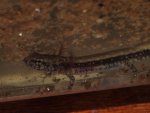Lamb
New member
- Joined
- Feb 28, 2009
- Messages
- 222
- Reaction score
- 12
- Points
- 0
- Age
- 37
- Location
- USA
- Country
- United States
Hello all,
The following little guy is around 2.5 cm in length and was found in a slow-flowing stream in a valley of a mixed-hardwood forest in south MS. I think it's a Eurycea, but when I was discussing the specimen with another grad student, he seemed very surprised that I was putting it in that genus, rather than in Desmognathus. From what I've read in keys, Desmog. gills tend to have short rami (the projections off of which the gill filaments, or fimbrae, project). Any experienced herpers have other tips for telling the two species apart as larvae?
The following little guy is around 2.5 cm in length and was found in a slow-flowing stream in a valley of a mixed-hardwood forest in south MS. I think it's a Eurycea, but when I was discussing the specimen with another grad student, he seemed very surprised that I was putting it in that genus, rather than in Desmognathus. From what I've read in keys, Desmog. gills tend to have short rami (the projections off of which the gill filaments, or fimbrae, project). Any experienced herpers have other tips for telling the two species apart as larvae?

